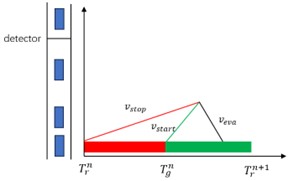Traffic Signal Priority Control Based on Traffic Wave Theory
Abstract
With the continuous growth in vehicle ownership, urban traffic congestion has become increasingly severe. Traditional transportation systems and urban road expansion are no longer sufficient to alleviate congestion or meet the mobility needs of residents. In recent years, the rapid development of the Internet of Vehicles (IoV) and vehicle–infrastructure cooperative technologies has opened new avenues for intelligent traffic management. In particular, how to effectively utilize the real-time information from connected vehicles and smart infrastructure to control the movement of connected buses and optimize traffic signal phases at intersections has become a key strategy for improving urban traffic efficiency.
This study focuses on signal timing optimization at connected signalized intersections. First, a vehicle waiting time prediction method based on traffic wave theory is introduced to estimate queue dynamics more accurately. Then, a connected transit signal priority (TSP) control model is developed, aiming to minimize the weighted waiting time of both connected buses and general traffic. The model is solved using a genetic algorithm to obtain the optimal signal timing strategy, thereby achieving effective signal priority control for connected buses.
References
[2] Liu, H., Skabardonis, A., & Zhang, W. B. (2003). A Dynamic Model For Adaptive Bus Signal Priority. In Proceedings of the 2003 IEEE Intelligent Transportation Systems Conference.
[3] Li, F., & Wang, J. (2010). Active transit signal priority considering overlapping phase in artery progression. In 2010 2nd International Conference on Advanced Computer Control (pp. 272–277). IEEE. https://doi.org/10.1109/ICACC.2010.5486672
[4] Liu, B., Zhao, Z., Niu, X., & Han, Z. (2012). Analysis of total passager delay at the intersection based on active bus priority strategy. In Proceedings of 2012 2nd International Conference on Computer Science and Network Technology (pp. 2191–2196). IEEE. https://doi.org/10.1109/ICCSNT.2012.6526353
[5] Liu, B., Zhao, Z., Niu, X., & Han, Z. (2012). Analysis of total passager delay at the intersection based on active bus priority strategy. In Proceedings of 2012 2nd International Conference on Computer Science and Network Technology (pp. 2191–2196). IEEE. https://doi.org/10.1109/ICCSNT.2012.6526353
[6] Li, S., Xu, H., Liang, Z., Ma, Y., & Wei, X. (2020). Bus Signal Priority Control Method Based on Video Detection Technology at Urban Intersection. In 2020 IEEE 5th International Conference on Image, Vision and Computing (ICIVC) (pp. 256–260). IEEE. https://doi.org/10.1109/ICIVC50857.2020.9177475
[7] Lytvynenko, M., Shkil, O., Filippenko, I., & Kholodova, O. (2020). Model and Means of Timed Automata-based Real-time Adaptive Transit Signal Control. In 2020 IEEE East-West Design & Test Symposium (EWDTS) (pp. 1–4). IEEE. https://doi.org/10.1109/EWDTS50664.2020.9225116
[8] Dong, X., Xiong, G., Kang, W., Zhang, Y., & Sun, Y. (2016). A kind of adaptive dynamic transit signal priority control method. In 2016 12th World Congress on Intelligent Control and Automation (WCICA) (pp. 999–1004). IEEE. https://doi.org/10.1109/WCICA.2016.7578695
[9] Ma, W., & Yang, X. (2008). Design and Evaluation of an Adaptive Bus Signal Priority System Base on Wireless Sensor Network. In 2008 11th International IEEE Conference on Intelligent Transportation Systems (pp. 1073–1077). IEEE. https://doi.org/10.1109/ITSC.2008.4732696
[10] Zhang, Y. (2020). An adaptive pre-signal setting to provide bus priority under a coordinated traffic-responsive network. In 2020 IEEE 23rd International Conference on Intelligent Transportation Systems (ITSC) (pp. 1–6). IEEE. https://doi.org/10.1109/ITSC45102.2020.9294380
[11] Xiong, L., Shi, G., Li, Z., & Leng, B. (2022). Integrated Optimization of Transit Signal Priority and Trajectory Planning for Autonomous Buses to Catch Green Light. In 2022 6th CAA International Conference on Vehicular Control and Intelligence (CVCI) (pp. 1–6). https://doi.org/10.1109/CVCI56766.2022.9964850


This work is licensed under a Creative Commons Attribution 4.0 International License.
Copyright for this article is retained by the author(s), with first publication rights granted to the journal.
This is an open-access article distributed under the terms and conditions of the Creative Commons Attribution license (http://creativecommons.org/licenses/by/4.0/).








1.png)














